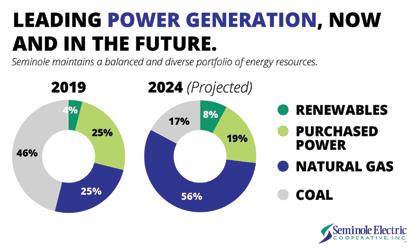
2 minute read
Florida Caverns State Park
by SVEC
Once completed, the new Seminole Combined Cycle Facility will be home to one of the most efficient units in the country.
The next generation
How Seminole Electric is preparing for the future
Suwannee Valley Electric Cooperative’s consumer-members know what it means to be part of an electric cooperative. But they may not know SVEC is itself a cooperative member.
Generating safe, affordable and reliable electricity can be both complicated and expensive. Because building our own generation facilities wouldn’t be cost-effective, SVEC and other electric cooperatives across the state of Florida created Seminole Electric Cooperative, a wholesale energy provider that generates and purchases electricity from a variety of resources.
Just like our consumer-members pay SVEC for their electricity, we are a member of Seminole and pay for the share of electricity our system uses. And just like SVEC, Seminole is a not-for-profit organization, meaning it is always looking for new ways to provide reliable electric service at a lower cost to its member cooperatives.
Recently, Seminole has been busy making upgrades and improvements that will improve the reliability, increase the efficiency and lower the cost of the electric service it provides to SVEC. Projects include construction of a natural gas-fired unit at the Seminole Combined Cycle Facility in Putnam County and the installation of upgraded turbines at the Midulla Generating Station in Hardee County.
“Seminole, just like SVEC, is a not-for-profit, member-owned electric cooperative, and we’re committed every day to providing safe, affordable, reliable electricity,” says Ryan Hart, Seminole’s director of communications and energy policy. “Part of that is making sure our fuel portfolio is as efficient as possible for our membership, and we think this provides us with valuable diversity.”
THE CUTTING EDGE
About five years ago, Seminole’s leadership gathered with its board of trustees to consider options for maintaining an affordable and reliable fuel mix. Several purchased-power agreements, which allow Seminole to buy additional electricity from other generators, were about to expire.
“We looked at all the different options, including solar and natural gas,” says Hart. “We did studies to determine which options were the most affordable and reliable. Ultimately, our board made the decision to build the Seminole Combined Cycle Facility.”
The new facility will be one of the most efficient combined-cycle generation units in the country, replacing one of the Seminole Generating Station’s coal units. The result will be a 40% reduction in air emissions, a 34% reduction in carbon dioxide emissions, and a 27% increase in power generated at the site.
Crews began clearing trees from the facility site and laying underground piping earlier this year. The project has continued with underground foundations and conduits currently being laid in preparation for above-ground construction, although some structural steel for the administration control building and maintenance shop are already in place.
“Once that’s done, we can start receiving equipment and putting that up,” says Tom Reed, project director for the SCCF project. “Overall, the project’s going very well. It’s still on budget and on schedule.”





